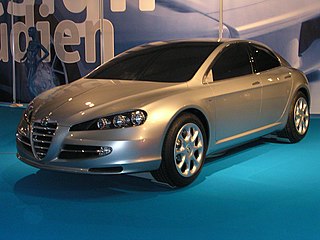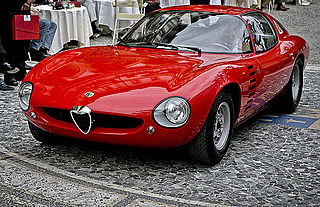
The Chevrolet Corvair is a compact car manufactured by Chevrolet for model years 1960–1969 in two generations. A response to the Volkswagen Beetle, it remains the only American-designed, mass-produced passenger car with a rear-mounted, air-cooled engine. The Corvair was manufactured and marketed in 4-door sedan, 2-door coupe, convertible, 4-door station wagon, passenger van, commercial van, and pickup truck body styles in its first generation (1960–1964) and as a 2-door coupe, convertible or 4-door hardtop in its second (1965–1969) – with a total production of approximately 1.8 million from 1960 until 1969.

Marcello Gandini is an Italian car designer, known for his work with the automotive design house Gruppo Bertone, including his designs of the Lamborghini Miura, Countach, and the Lamborghini Diablo.

The Bugatti EB 118 is the first concept car developed by Bugatti Automobiles S.A.S. The 2-door coupé was presented at the 1998 Paris Motor Show. Bugatti commissioned the design of the EB 118 from Giorgetto Giugiaro of Italdesign. The EB 118 is powered by a W18 engine and has permanent four wheel drive.

The Bugatti EB 218 saloon is the second concept car presented by Bugatti under the ownership of the Volkswagen Auto Group. The EB 218 was designed by Giorgetto Giugiaro, who also designed the EB 112, the car's predecessor and the EB 118, the car's 2-door variant. The EB 218 can be considered as an update of the EB 112, a concept saloon introduced by Bugatti Automobili SpA in 1993. The EB 218 features Volkswagen's unconventional W18 engine and permanent four-wheel drive borrowed from the Lamborghini Diablo VT.

The Chevrolet Turbo-Air 6 is a flat-six air-cooled automobile engine developed by General Motors (GM) in the late 1950s for use in the rear-engined Chevrolet Corvair of the 1960s. It was used in the entire Corvair line, as well as a wide variety of other applications.

The Alfa Romeo 2000 is a luxury car produced by Italian car manufacturer Alfa Romeo between 1958 and 1962, as a successor to the 1900 Super. It was replaced in 1962 by the Alfa Romeo 2600.

The Alfa Romeo 2600 was Alfa Romeo´s six-cylinder flagship produced from 1962 to 1968. It was the successor to the Alfa Romeo 2000. It has become historically significant as the last Alfa Romeo to have been fitted with an inline six-cylinder engine with twin overhead camshafts. That had been the traditional Alfa Romeo engine configuration since the 1920s, but gave way to four-cylinder engines as the factory oriented its production towards more economical mass-produced car models starting in 1950.

The Alfa Romeo 33 Stradale is a mid-engine sports car built by Italian automobile manufacturer Alfa Romeo. It was the fastest commercially available car for the standing kilometer upon its introduction. 18 examples were produced between 1967 and 1969. "Stradale" is a term often used by Italian car manufacturers to indicate a street-legal version of a racing car; indeed the 33 Stradale was derived from the Tipo 33 sports prototype. Built in an attempt by Alfa Romeo to make some of its racing technology available to the public, it was also the most expensive automobile for sale to the public in 1968 at US$17,000.

The Giugiaro Mustang is a concept car based on the production fifth generation Ford Mustang that debuted at the 2006 Los Angeles International Auto Show. It was designed by Italdesign Giugiaro under Fabrizio Giugiaro, Giorgetto Giugiaro's son. The 2015 Ford Mustang takes many design cues from the concept car.

The ChevroletCorvair Monza GT (XP-777) was a mid-engined experimental prototype automobile built in 1962 and based on the early model Chevrolet Corvair series. As it was essentially a concept car, the Monza GT did not enter production.

The Alfa Romeo Visconti is a concept car made by the Italian car manufacturer Alfa Romeo, designed by Giorgetto Giugiaro. The car was seen for the first time at the Geneva Motor Show in 2004. The car is a four-door fastback coupé/sedan and is almost 5 metres (200 in) long. Under the bonnet is a 3.2-litre V6 JTS biturbo engine, which produces 405 PS at 6000 rpm and 680 N⋅m (502 lbf⋅ft) of torque at 2000 rpm.

The Alfa Romeo Giulietta Sprint Speciale and Alfa Romeo Giulia Sprint Speciale, also known as Giulietta SS and Giulia SS, are small sports cars manufactured by Alfa Romeo from 1959 to 1966.

The Alfa Romeo Caimano is a concept car designed by Giorgetto Giugiaro of Italdesign and presented at the Turin Motor Show in 1971. The car is exhibited at the Museo Storico Alfa Romeo.

The Alfa Romeo Canguro is a concept car designed by Giorgetto Giugiaro at Bertone. The car is based on the chassis of an Alfa Romeo TZ and was shown at the 1964 Paris Motor Show. The body is made of fiberglass rather than aluminium and it features one of the first glued in windscreens in a car. The name "Canguro" means Kangaroo in Italian.

The Alfa Romeo Iguana is a concept car produced by Alfa Romeo in 1969. It was designed by Giorgetto Giugiaro at Italdesign.
Anatole Carl "Tony" Lapine was an automotive designer and racing driver. Lapine worked for General Motors (GM), Opel, and Porsche. During his time as chief designer at Porsche he oversaw development of the front-engined, water-cooled 928, 924 and 944 that began to appear in the mid to late 1970s, as well as two revisions to the Porsche 911.

The Lancia Stratos Zero or Lancia Stratos HF Zero is a grand tourer concept sports car from the Italian automobile manufacturers Bertone and Lancia which was presented at the 1970 Turin Auto Show.


















